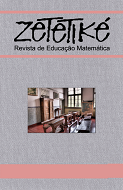Abstract
The aim of this paper is to research how the creative process takes place in the individual, to seek teaching methodologies that stimulate creativity. Going through concepts/definitions of creativity and models of creative thinking, the paper briefly presents the results of an activity of producing student video lessons in two classes of integrated high school students from the IFSul Campus Pelotas, in which the occurrence (or not) of the phases described in the Wallas and Hadamard models was analyzed through continuous monitoring and application of a questionnaire: preparation, incubation, lighting, and verification. In conclusion, it was possible to verify the occurrence of these four phases, which highlights that creativity is a quality that all individuals have, to a greater or lesser degree, and that can be developed (encouraged) as it provides knowledge and environment that contribute to their progress.
References
Alencar, E. S. de, & Fleith, D. de S. (2003). Criatividade: Múltiplas perspectivas (3o ed). Editora Universidade de Brasília.
Bucho, J. L. C. (2016). Relação entre Ying-Yang e a criatividade. Psicologia.pt - O Portal dos periódicos. (pp. 1-12). Disponível em: https://www.psicologia.pt/artigos/textos/A0971.pdf
Damiani, M. F., Rochefort, R. S., Castro, R. F. de, Dariz, M. R., & Pinheiro, S. N. S. (2013). Discutindo pesquisas do tipo intervenção pedagógica. Cadernos de Educação (UFPel), 45, 57–67. https://doi.org/10.15210/CADUC.V0I45.3822
Eagleman, D., & Brandt, A. (2020). Como o cérebro cria: O poder da criatividade humana para transformar o mundo. Intrínseca.
Faria, A. C., Perneta, A. F., Teixeira, C. M., & Félix, F. F. (2018). A complexidade da criatividade. In M. Pocinho & S. Garcês (Orgs.), Psicologia da criatividade (pp. 20-46). Funchal: Universidade da Madeira.
Furtado, C. (2021). Gênio Louco? Criatividade, Genialidade e Loucura -. MELKBERG. Retirado em novembro de 2021 de: https://melkberg.com/2021/02/05/genio-louco-criatividade-genialidade-e-loucura/
Gardner, H. (1996). Mentes que criam (1o ed). Artmed.
Gontijo, C. H., Carvalho, A. T. de, Fonseca, M. G., & Farias, M. P. de. (2019). Criatividade em matemática: Conceitos, metodologias e avaliação. Em Portal de Livros da UnB. Editora Universidade de Brasília. https://doi.org/10.26512/9788523010195
Hadamard, J. (2009). Psicologia da invenção matemática. Contraponto.
Haetinger, M. G., & Arantes, A. C. (2008). Criatividade e sua importância para a educação. IESDE Brasil S.A.
Lubart, T. (2007). Psicologia da criatividade. Artmed.
Oliveira, Z. M. F. de, & Alencar, E. M. L. S. de. (2008). A criatividade faz a diferença na escola: O professor criativo e o ambiente facilitador da criatividade. Revista Contrapontos, 8(2), 295-306. https://siaiap32.univali.br/seer/index.php/rc/article/view/954/810
Pereira, J., Proença, K., & Alves, L. (2022). Professores, conhecem os 10 passos para produzir vídeos com os alunos? Editora Rubra Cinematográfica.
Wechsler, S. M., & Nakano, T. de C. (2020). Dimensões da criatividade segundo Paul Torrance. In M. Pereira & D. Fleith (Orgs.), Teorias da criatividade (pp. 15-46). Campinas: Alínea.

This work is licensed under a Creative Commons Attribution-NonCommercial-NoDerivatives 4.0 International License.
Copyright (c) 2023 Zetetiké


